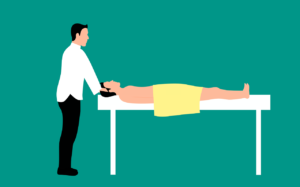
Have you ever woken up with a nagging pain in your shoulder after a seemingly peaceful night’s sleep? If so, you’re not alone. Shoulder pain after sleeping is a common issue that can disrupt your daily routine and leave you feeling frustrated. But fret not, because in this article, we will explore some practical and effective remedies to alleviate this discomfort. So, say goodbye to those painful mornings and get ready to regain your peaceful slumber.

Stretching exercises
1.1 Shoulder rolls
Shoulder rolls are a great way to relieve tension and loosen up the muscles in your shoulders. Start by sitting or standing up straight, with your arms relaxed at your sides. Slowly roll your shoulders forward in a circular motion, making sure to keep them relaxed throughout the movement. Repeat this exercise for about 10-15 times, then reverse the direction and roll your shoulders backward.
1.2 Seated twist
To perform a seated twist, start by sitting on a chair with your feet flat on the floor. Place your right hand on your left knee, and gently twist your upper body to the left, using your hand to guide the movement. Hold this position for about 15-30 seconds, then switch sides and repeat the exercise on the other side. This stretch helps to release tension in the shoulders and upper back.
1.3 Doorway stretch
The doorway stretch is a simple yet effective stretch to relieve shoulder pain. Stand in a doorway with your arms outstretched and place your hands on the doorframe at shoulder height. Slowly lean forward, allowing your body to stretch the muscles in your shoulders. Hold this position for about 15-30 seconds, and then relax. Repeat the stretch a few times to further loosen up the muscles.
1.4 Arm circles
Arm circles are a great exercise to warm up the muscles in your shoulders before engaging in any physical activity. Stand with your feet shoulder-width apart and extend your arms out to the sides at shoulder height. Begin by making small circles with your arms, gradually increasing the size of the circles. After about 10 revolutions, reverse the direction and make circles in the opposite direction. Perform this exercise for a few minutes to help reduce shoulder pain.
1.5 Cross-body stretch
The cross-body stretch targets the muscles in your shoulders and upper back, helping to alleviate pain and improve flexibility. Start by standing or sitting up straight. Take your right arm and gently bring it across your body, using your left hand to pull the right arm closer to your chest. Hold this position for about 15-30 seconds, then switch sides and repeat with the left arm. This stretch can be performed multiple times throughout the day to relieve shoulder pain.
Proper sleeping position
2.1 Side sleeping with a pillow
Sleeping on your side can help alleviate shoulder pain, especially if you use a pillow for support. Place a pillow between your legs to align your hips and reduce strain on your shoulders. Additionally, you can hug a pillow against your chest to support your upper body and prevent excessive rotation of the shoulders. This position helps to relieve pressure on the shoulders and promotes better sleep.
2.2 Back sleeping with a pillow
If you prefer sleeping on your back, using a pillow can help maintain proper alignment and reduce shoulder pain. Place a pillow under your knees to support the natural curve of your spine and relieve pressure on your shoulders. You can also place a small pillow or rolled-up towel under your lower back for extra support. This position ensures that your shoulders are not bearing the weight of your body, reducing strain and pain.
2.3 Avoiding stomach sleeping
Sleeping on your stomach can exacerbate shoulder pain as it puts pressure on the joints and muscles. When you sleep on your stomach, your head may be turned to one side, causing additional strain on the neck and shoulders. It is best to avoid this position altogether to prevent further discomfort and promote a healthier sleeping posture.
2.4 Using a supportive mattress and pillow
Investing in a supportive mattress and pillow is crucial to maintaining good sleep posture and preventing shoulder pain. Look for a mattress that provides adequate support for your body, especially around the shoulder area. A pillow that conforms to the natural shape of your neck and supports your head properly can also make a significant difference. Experiment with different types and firmness levels to find the best combination for your specific needs.

Heat and cold therapy
3.1 Applying a heating pad
Applying a heating pad to your shoulders can help relax the muscles, relieve tension, and reduce pain. Simply place the heating pad on your shoulders and adjust the temperature to a comfortable level. Leave it on for about 15-20 minutes, making sure to follow the manufacturer’s instructions for safe use. The warmth from the heating pad increases blood flow to the area, providing relief from shoulder pain.
3.2 Using a warm towel
If you don’t have a heating pad, a warm towel can be a great alternative for heat therapy. Wet a towel with warm water, wring out any excess moisture, and place it on your shoulders. You can also fill a basin with warm water and soak a towel in it before applying it to your shoulders. Leave the warm towel on for about 15 minutes, and repeat as needed to soothe and relax your shoulder muscles.
3.3 Ice pack application
Ice packs are beneficial for reducing inflammation and numbing pain in the shoulder area. Wrap an ice pack or a bag of frozen vegetables in a thin cloth to protect your skin, then apply it to your shoulders for about 15-20 minutes. Make sure to take breaks between applications to prevent skin damage. Ice therapy is particularly useful if you experience swelling or acute pain in your shoulders.
Over-the-counter pain medication
4.1 Nonsteroidal anti-inflammatory drugs (NSAIDs)
Nonsteroidal anti-inflammatory drugs, such as ibuprofen or naproxen sodium, can help reduce inflammation and alleviate shoulder pain. Follow the instructions on the packaging for the recommended dosage and duration of use. It is essential to consult with a healthcare professional before taking any medication to ensure it is suitable for your specific condition and any other medications you may be taking.
4.2 Acetaminophen
Acetaminophen, also known as paracetamol, is a pain reliever that can help alleviate shoulder pain. It is particularly effective for reducing pain caused by muscle strains or tension. Again, it is crucial to follow the instructions for the recommended dosage and avoid exceeding the maximum daily limit. If your pain persists or worsens, consult a healthcare professional for further guidance.

Lifestyle modifications
5.1 Adequate rest
Getting enough rest and sleep is essential for your overall well-being, including your shoulder health. Aim for 7-9 hours of quality sleep each night to allow your body to recover and repair. If shoulder pain keeps you awake at night, try adjusting your sleeping position or incorporating some of the previously mentioned techniques to alleviate discomfort and promote restful sleep.
5.2 Posture improvement
Improving your posture can have a significant impact on shoulder pain. Be mindful of your posture throughout the day, whether sitting, standing, or engaging in any activities. Keep your shoulders relaxed and pulled back, avoiding slouching or rounding your upper back. Incorporate posture-improving exercises, such as shoulder squeezes and upper back stretches, into your daily routine to strengthen the muscles that support good posture.
5.3 Weight management
Maintaining a healthy weight can reduce pressure and strain on your shoulders. Excess weight puts additional stress on your joints and muscles, contributing to shoulder pain. If you are overweight, consider implementing a balanced diet and regular exercise routine to gradually achieve a healthier weight, which may alleviate shoulder discomfort and improve overall well-being.
5.4 Regular exercise routine
Engaging in regular exercise is crucial for shoulder health and overall fitness. Incorporate exercises that target the muscles in your shoulders, such as shoulder presses, rows, and lateral raises. Strengthening these muscles can help improve posture, reduce pain, and prevent future injuries. Additionally, include cardiovascular exercises and full-body workouts to promote overall strength and flexibility.
5.5 Neck and shoulder strengthening exercises
Specific neck and shoulder strengthening exercises can help alleviate shoulder pain and improve stability in the area. Consider incorporating exercises like shoulder shrugs, lateral neck stretches, and scapular squeezes into your routine. Start with light weights or resistance bands and gradually increase the intensity as your strength improves. Consult with a physical therapist or fitness professional for guidance on proper form and technique.
Massage therapy
6.1 Self-massage techniques
Self-massage can be a simple and effective way to relieve tension and reduce shoulder pain. Use your opposite hand or a massage ball to apply gentle pressure to the affected area, moving in circular motions. You can also try using a foam roller against a wall to massage your shoulders and upper back. Experiment with different techniques and pressure levels to find what works best for you.
6.2 Professional massage therapy
If self-massage techniques are not providing sufficient relief, consider seeking professional massage therapy. A licensed massage therapist can target the specific muscles and areas causing shoulder pain, using various techniques like deep tissue massage or Swedish massage. Regular massage sessions can help reduce muscle tension, improve blood circulation, and alleviate chronic shoulder pain.
Sleep environment adjustments
7.1 Supportive pillows
Choosing the right pillows for your sleep position and shoulder needs can significantly improve your sleep environment. Look for pillows that provide adequate support and alignment for your head, neck, and shoulders. Memory foam or contour pillows can be particularly beneficial, as they conform to the natural curves of your body. Experiment with different pillow sizes and types to find the most comfortable option for your individual needs.
7.2 Adjusting room temperature
Creating a comfortable sleep environment includes maintaining an optimal room temperature. Cooler temperatures generally promote better sleep quality, so try to keep your bedroom slightly cool. Experiment with different temperature settings and bedding materials to find what provides you with the most soothing and restful sleep. Additionally, consider using a fan or white noise machine if external sounds disrupt your sleep.
7.3 Darkening curtains
Light exposure can affect your sleep quality and potentially contribute to shoulder pain. Invest in blackout curtains or blinds to block out external light sources and create a dark sleep environment. This can help signal your body to produce melatonin, the hormone that regulates sleep. Darkening your room can promote better sleep initiation and maintenance, allowing your body to rest and recover more effectively.
Posture corrective devices
8.1 Shoulder braces or supports
Shoulder braces or supports can be beneficial for improving posture and reducing shoulder pain. These devices help pull your shoulders back and align them in a more neutral position, relieving strain on the muscles and joints. Ensure you choose a brace or support that fits properly and provides the appropriate level of support for your specific needs. Consult with a healthcare professional for guidance on selecting and using these devices correctly.
8.2 Posture corrector shirts
Posture corrector shirts are wearable garments designed to promote proper posture alignment by providing support to the shoulders and upper back. These shirts use tension straps or elastic panels to gently pull the shoulders back into a more aligned position. Posture corrector shirts can be a helpful tool in improving your posture and reducing shoulder pain, but it is important to follow the manufacturer’s instructions for safe and effective use.
Physical therapy
9.1 Range of motion exercises
Physical therapy exercises can target specific range of motion limitations and help improve flexibility in the shoulders. These exercises involve gentle movements and stretches that aim to increase the mobility of your shoulder joints. Consult with a physical therapist for a personalized exercise plan that addresses your specific needs and limitations.
9.2 Strengthening exercises
Strengthening exercises play a crucial role in shoulder rehabilitation. These exercises target the muscles in and around the shoulders to improve stability and support for the joints. Examples of strengthening exercises for the shoulders include resistance band exercises, dumbbell exercises, and bodyweight exercises like push-ups. Working with a physical therapist can ensure that you perform these exercises correctly and safely.
9.3 Manual therapy
Manual therapy techniques performed by a physical therapist can help alleviate shoulder pain and improve range of motion. These techniques may include joint mobilization, soft tissue massage, and stretching. Manual therapy sessions are tailored to your specific needs and may involve a combination of hands-on techniques and exercises to address your shoulder pain effectively.
9.4 Electrical stimulation
Electrical stimulation is a physical therapy treatment modality that can help relieve pain and reduce muscle tension in the shoulders. This therapy involves placing electrodes on the skin over the affected area, which deliver low-level electrical currents to the muscles. The electrical impulses can stimulate nerves, promote blood flow, and help relax muscle spasms, providing pain relief and improving overall shoulder function.
9.5 Ultrasound therapy
Ultrasound therapy is a noninvasive treatment that uses high-frequency sound waves to alleviate pain and promote healing in the shoulders. During the therapy session, a physical therapist applies a handheld device to the skin over the affected area, which emits the sound waves. The waves penetrate deep into the muscles and soft tissues, increasing circulation and reducing inflammation, helping to manage shoulder pain.
Restorative sleep practices
10.1 Establishing a bedtime routine
Creating a consistent bedtime routine can signal your body that it’s time to wind down and prepare for sleep. Establish relaxing activities before bed, such as taking a warm bath, reading a book, or practicing gentle stretching or meditation. Avoid stimulating activities, screens, and bright lights in the hours leading up to bedtime. By establishing a routine, you can enhance your sleep quality and minimize shoulder pain.
10.2 Meditation and relaxation techniques
Incorporating meditation and relaxation techniques into your daily routine can help alleviate stress and tension in your shoulders and promote better sleep. Practice deep breathing exercises, progressive muscle relaxation, or guided meditation to promote relaxation of both your mind and body. These techniques can serve as powerful tools to calm your mind and reduce muscle tension, providing relief from shoulder pain.
10.3 Sleep hygiene habits
Establishing good sleep hygiene habits can significantly impact your overall sleep quality and shoulder health. Create a sleep-friendly environment by keeping your bedroom cool, dark, and quiet. Stick to a consistent sleep schedule, even on weekends, to regulate your body’s internal clock. Limit caffeine and alcohol intake, especially close to bedtime, as they can disrupt your sleep. By prioritizing good sleep hygiene, you can ensure restorative sleep and prevent shoulder pain caused by poor sleep quality.
Incorporating these effective remedies for shoulder pain into your daily routine can help alleviate discomfort, improve mobility, and promote better sleep. Remember to consult with a healthcare professional before starting any new exercise, therapy, or medication regimen, especially if you have underlying health conditions or chronic shoulder pain. With consistency and diligence, you can effectively manage and reduce shoulder pain, leading to a healthier, pain-free lifestyle.







